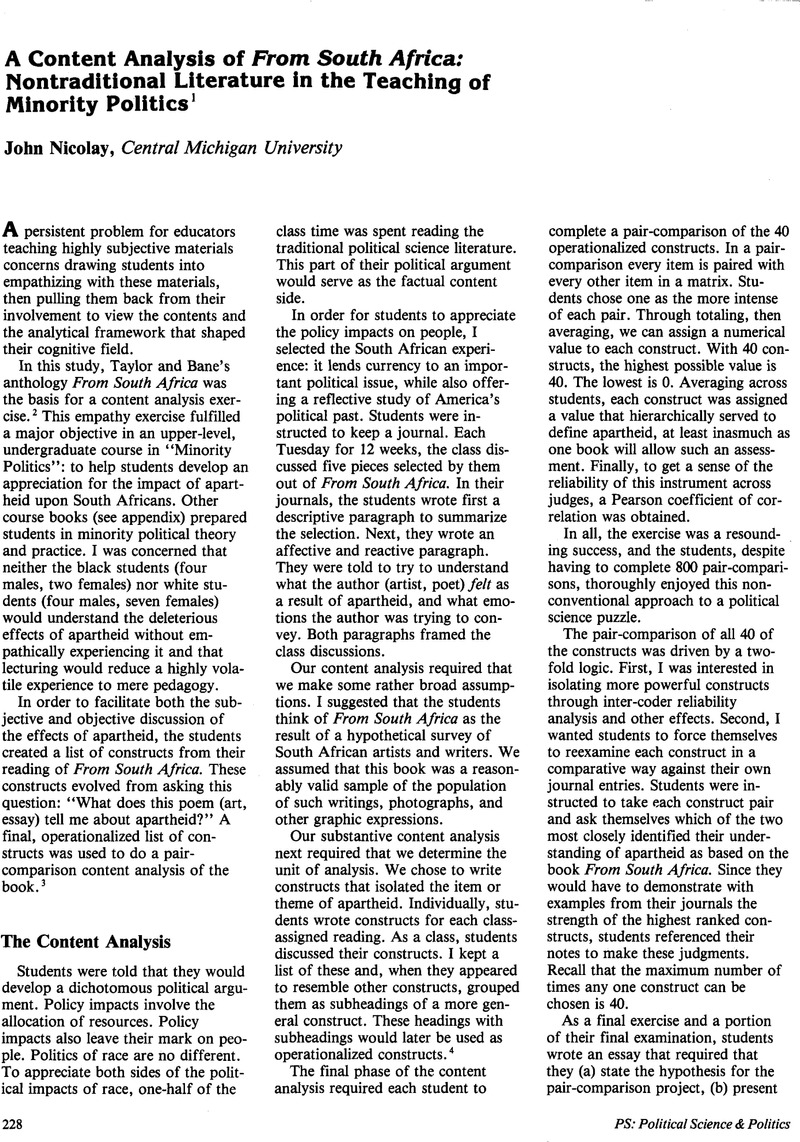No CrossRef data available.
Article contents
A Content Analysis of From South Africa: Nontraditional Literature in the Teaching of Minority Politics
Published online by Cambridge University Press: 02 September 2013
Abstract

- Type
- News
- Information
- Copyright
- Copyright © The American Political Science Association 1992
Footnotes
My appreciation to my students, and specifically to Tim Mann, Lee Ann Sieveking, Susan Tinsley, Len Wentz and Stacy O'Neill for sharing their journal insights with the world. This exercise was completed during the 1989–90 fall term at Virginia Polytechnic Institute and State University. Due to limitations in space, the entire study is not presented here. Readers who desire a copy of the course syllabus or the full-blown content analysis are encouraged to write the author.
References
Notes
2. Bunn, David and Taylor, Jane, editors, From South Africa, Chicago: University of Chicago Press, 1987.Google Scholar
3. For a review please see North, James, “Voices of Hope: Anthology Captures South Africa's Pain and Promise,” Chicago Tribune, October 25, 1987, Section 14 (Books), pp. 6–7.Google Scholar
4. Please refer to Mannheim, Jarol B. and Rich, Richard C., Empirical Political Analysis: Research Methods in Political Science, 2nd edition, White Plains, NY: Longman Inc., 1986, pp. 152–63Google Scholar; and Babbie, Earl, The Practice of Social Research, 4th edition, Belmont, CA: Wadsworth Press, 1986, pp. 266–83.Google Scholar
5. The works of Alan Paton, Toni Morrison, and Chinua Achebe belong in this group. For a broadly stroked discussion, please see Merriam, Allen H. (1988), “Literature as Window: Developing Interracial Understanding Through Fiction,” Journal of Black Studies 19: 61–69 CrossRefGoogle Scholar; Okur, Nilgun Anadolu (1989), “Drama as Social Criticism: Assessing Baraka's Great Goodness of Life ,” Journal of Black Studies 19: 411–21.CrossRefGoogle Scholar
6. Most recently, Merritt, Bishetta P. (1986), “Jesse Jackson and Television: Black Image Perception and Affect in the 1984 Democratic Campaign Debates,” Journal of Black Studies 16: 347–67CrossRefGoogle Scholar; and Shull, Steven A. and Ringelstein, Albert C. (1989), “Presidential Attention, Support, and Symbolism in Civil Rights, 1953–1984,” The Social Science Journal 26: 45–54.CrossRefGoogle Scholar
7. A slightly different variation of this model can be used for pre-determined constructs. A very nice discussion is Davis, Todd M. and McLean, James E. (1988), “Simplifying Ranking Tasks in Survey Research: A Method and Example,” Psychological Reports 62: 987–92.CrossRefGoogle Scholar
8. Woodrum, Eric (1984), “‘Mainstreaming’ Content Analysis in Social Science: Methodological Advantages, Obstacles and Solutions,” Social Science Research 13: 1–19.CrossRefGoogle Scholar
9. Content analysis is a useful way of drawing emotion from words. In her study, Shimanoff, Susan B. [(1985) “Expressing Emotions in Words: Verbal Patterns of Interaction,” Journal of Communication 35 (Summer): 16–31]CrossRefGoogle Scholar demonstrates that the analysis of verbal contents for affect can produce statistically significant interrater reliability scores on fairly simple coding schedules.




